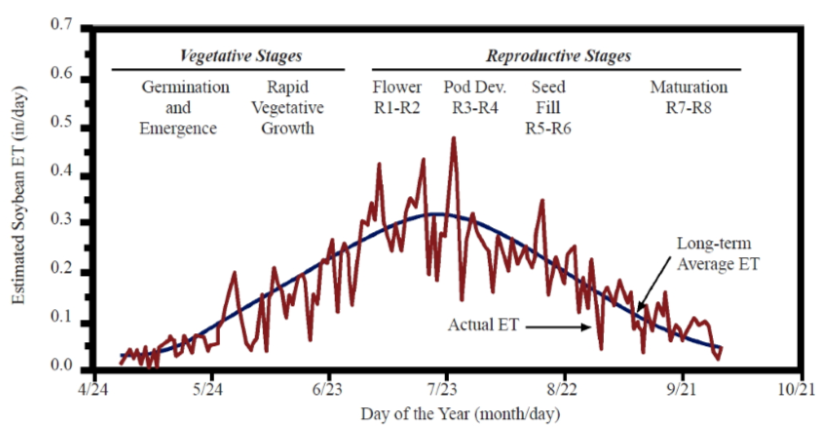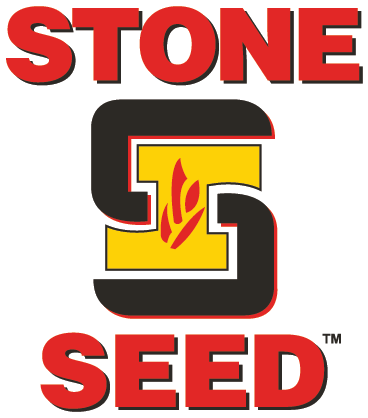- Crop water use is influenced by weather conditions, crop growth stage, and several other factors. Soybean water use rates peak during the mid-reproductive stages.
- When soybean does not receive enough water to meet evapotranspiration demands during the reproductive growth stages, significant reductions in yield can occur.
- Understanding how soybean water use changes throughout the season can help guide more efficient irrigation applications.
Evapotranspiration (ET)
The terms crop water use and evapotranspiration (ET) are used synonymously to describe the movement of water through evaporation (E) from the soil and plant surfaces and transpiration (T) through the plant. Transpiration is the movement of water from the soil into plant roots, through plant stems and leaves, and back out into the atmosphere. Transpiration is an important concept because yield is linearly related to the amount of water a soybean plant transpires. An understanding of the critical water use periods for maximizing yield potential in soybean can help guide more efficient irrigation applications.
Factors that Influence ET
Soybean water use will fluctuate throughout the season depending on weather conditions and crop growth stage (Figure 1). Factors that will affect ET and irrigation decisions include:

Crop growth stage. Soybean water requirements change throughout the season (Table 1). Young plants transpire less than larger plants due to a smaller leaf surface area. Soybean requires the most water from flowering through seed fill.

Relative maturity. A full-season soybean product will use more water over the course of the season compared to a shorter-season product grown in the same location. While longer-season soybean products use more water, they may also have a higher yield potential if growing conditions are optimal.
Weather conditions. The ability of the atmosphere to evaporate water is the driving force for ET. Daily ET is influenced by solar radiation, air temperature, relative humidity, and wind. High air temperatures, low humidity, clear skies, and high winds cause a large evaporative demand.
Soil water holding capacity and soil water content. Soil type dictates the maximum amount of water a soil can hold and how much of that water will be available to plants. Fine textured soils can hold more water than coarse textured soils. As the soil dries, it becomes more difficult for plants to extract water. When the soil water profile is full (field capacity), plants use water at the maximum rate. As the water content of the soil drops, plants are less able to extract the water.
Residue management / tillage system. The soil water evaporation component of ET can be reduced with conservation tillage and increased surface crop residue. Tillage increases the exposed surface area of the soil which increases evaporation and runoff, destroys crop residue that can catch rain and snow, and may reduce water infiltration because of compaction that can be created during the tillage process. Surface residue helps increase infiltration rates by limiting the amount of surface sealing created by rainfall and irrigation droplets. Surface residue also helps reduce runoff by creating obstructions that limit water movement and allow more time for water to seep into the soil profile.
Crop population. When water resources are limited, populations can be lowered to reduce the transpiration component of ET and better match precipitation, stored soil moisture, and irrigation water supplies to crop requirements. However, soybean has the ability to adjust growth and development to compensate for different plant densities with a tendency to produce more branches and pods in low populations.
Soybean Water Use and Irrigation Requirements by Growth Stage
Soybeans require approximately 15 inches to over 25 inches of water per year depending on planting date, maturity group, location, and weather conditions.1,2 The most important time to avoid water stress is during the mid- to late-reproductive stages. Significant reductions in yield can occur if soybean does not receive enough water to meet ET demands during this critical water use period.
Emergence and vegetative stages. The water demands of soybean are relatively low during the seedling stage and increase significantly during rapid vegetative growth. Unless the soil is extremely dry, supplemental irrigation is not recommended during germination or vegetative growth stages. Too much water early in the season can prolong the vegetative growth stage, which can result in flowering delays, increased plant height, and lodging.2 Limiting irrigation at this stage encourages plants to develop stronger, healthier root systems that grow deeper. Farmers should rely on stored soil moisture and natural precipitation as much as possible during the early growth stages.

Reproductive stages to maturity. Soybeans need the most water during the reproductive stages; about 65% of water use occurs from R1 (beginning flower) through maturity.2 Soybeans are most sensitive to water stress during the mid- to late-reproductive stages: pod development (R3 to R4) and seed fill (R5 to R6). Water stress during pod development and early seed fill can have the greatest impact on yield potential and result in a reduced number of seeds per pod and reduced seed size. Irrigation may be required during flowering if conditions are exceptionally dry or on soils with an insufficient water holding capacity that dry out quickly.2 When water is applied during flowering, it is especially important to supply adequate water during seed fill. This is because irrigation during flowering usually increases the number of seeds produced, but subsequent water stress during seed fill will reduce the seed size which can result in greater yield penalties than would have occurred if the crop had not been watered at all during flowering.2
 Figure 2. Soybean flowering
Figure 2. Soybean flowering
 Figure 3. Pod fill and development
Figure 3. Pod fill and development
Soybean requires adequate water through the reproductive stages in order for seeds to achieve their maximum weight (Table 2). Discontinuing irrigation too soon can result in yield penalties if the soil water content is not sufficient to bring the crop through physiological maturity without inducing stress.

Plan Ahead to Avoid Water Stress
Soybean water demands often exceed precipitation amounts during the critical reproductive stages. Under the hot, dry July and August conditions of semi-arid regions like western Nebraska, peak water demand can reach up to 0.5 inches per day.2 It is important to plan ahead by knowing the capacity of the irrigation system to ensure that adequate water is available to the crop through maturity.
Sources
1Soybean irrigation and water use. University of Missouri Extension. http://crops.missouri.edu/irrigation/.
2Kranz, W.L. and Specht, J.E. 2012. Irrigating soybean. NebGuide G1367. University of Nebraska-Lincoln Extension.
Other Sources: Helsel, D.G. and Helsel, Z.R. 1993. Irrigating soybeans. Publication G4420. University of Missouri Extension. Web sources verified 4/1/15. 150315145957
